 Our Lord and Savior Jesus Christ gave the great Commission to “go and make disciples of all nations…” A number of Lutheran churches in the 1970’s had a unique opportunity to do exactly that by sharing the Good News of Jesus with Hmong immigrants. Our Savior, Lansing, is reflecting on 47 years of Hmong Ministry that saw 389 souls baptized into Christ. It is a remarkable chapter in this congregation’s history and the history of the Lutheran Church in the United States which demonstrates the power of the Gospel to transcend language and culture as it reaches people with the Gospel.
Our Lord and Savior Jesus Christ gave the great Commission to “go and make disciples of all nations…” A number of Lutheran churches in the 1970’s had a unique opportunity to do exactly that by sharing the Good News of Jesus with Hmong immigrants. Our Savior, Lansing, is reflecting on 47 years of Hmong Ministry that saw 389 souls baptized into Christ. It is a remarkable chapter in this congregation’s history and the history of the Lutheran Church in the United States which demonstrates the power of the Gospel to transcend language and culture as it reaches people with the Gospel.
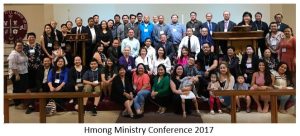 During the Vietnam War (1965-1973), the U.S. military was aided by a local ethnic group called the Hmong, who lived in the mountains of Laos, Vietnam, and Thailand. The Hmong were a freedom loving people who were fighting against the communist takeover of these countries. They fled persecution from the Chinese in the 18th and 19th centuries and maintained their unique language, culture, and identity. They are a people without a homeland. In the 1960’s, tens of thousands of Hmong men were recruited by the CIA for their secret operations in Laos. Others assisted the American military in Vietnam, guiding soldiers through the thick jungles, interpreting, and infiltrating the Viet Cong. They were known to be courageous and loyal. When the U.S. withdrew from Vietnam, the communists retaliated against the Hmong by trying to kill them. Many families fled across the border into Thailand by swimming across the Mekong River, often under gunfire. Several of them lost family members there in the river. Those who survived were gathered into refugee camps before being sent to the United States. The U.S. gave veteran status to the Hmong who assisted in the Vietnam War and the Secret War in Laos, and allowed their families to settle in America. Refugee agencies and immigrant ministries prepared themselves for the arrival of 30,000 Hmong in 1978. This is when the Lutherans stepped up in a big way.
During the Vietnam War (1965-1973), the U.S. military was aided by a local ethnic group called the Hmong, who lived in the mountains of Laos, Vietnam, and Thailand. The Hmong were a freedom loving people who were fighting against the communist takeover of these countries. They fled persecution from the Chinese in the 18th and 19th centuries and maintained their unique language, culture, and identity. They are a people without a homeland. In the 1960’s, tens of thousands of Hmong men were recruited by the CIA for their secret operations in Laos. Others assisted the American military in Vietnam, guiding soldiers through the thick jungles, interpreting, and infiltrating the Viet Cong. They were known to be courageous and loyal. When the U.S. withdrew from Vietnam, the communists retaliated against the Hmong by trying to kill them. Many families fled across the border into Thailand by swimming across the Mekong River, often under gunfire. Several of them lost family members there in the river. Those who survived were gathered into refugee camps before being sent to the United States. The U.S. gave veteran status to the Hmong who assisted in the Vietnam War and the Secret War in Laos, and allowed their families to settle in America. Refugee agencies and immigrant ministries prepared themselves for the arrival of 30,000 Hmong in 1978. This is when the Lutherans stepped up in a big way.
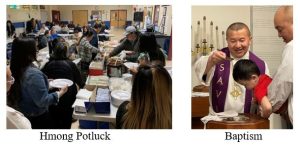 Churches like Our Savior in Lansing prayerfully considered helping the Hmong resettle in the United States. At Our Savior, a ministry team was formed to welcome the Hmong at the Detroit airport as they arrived on American soil. The team was led by a teacher in the school, Mr. Richard Hackbarth. They helped the refugees find initial housing, get jobs, and fill out the paperwork. Their children were welcomed as students in Our Savior Lutheran School. The language barrier was significant, and most Hmong families had never left their village before that point. With patience, love, and commitment, the Lutherans in Lansing welcomed and assisted these families. The first family in 1978 was the Nao Lu Lee family. They were followed by several others. Those who came to faith in Christ were baptized, renouncing their animist religion, sometimes over a dozen at a time.
Churches like Our Savior in Lansing prayerfully considered helping the Hmong resettle in the United States. At Our Savior, a ministry team was formed to welcome the Hmong at the Detroit airport as they arrived on American soil. The team was led by a teacher in the school, Mr. Richard Hackbarth. They helped the refugees find initial housing, get jobs, and fill out the paperwork. Their children were welcomed as students in Our Savior Lutheran School. The language barrier was significant, and most Hmong families had never left their village before that point. With patience, love, and commitment, the Lutherans in Lansing welcomed and assisted these families. The first family in 1978 was the Nao Lu Lee family. They were followed by several others. Those who came to faith in Christ were baptized, renouncing their animist religion, sometimes over a dozen at a time.
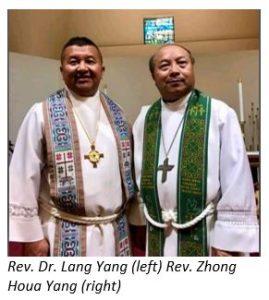 A Christian Hmong interpreter named Zhong Houa Yang came from Pennsylvania to Lansing to assist with Hmong ministry at Our Savior. He helped Pastor Bickel share the Christian faith with the Hmong, young and old, and by 1984, around 100 Hmong had been baptized at Our Savior by Pastor Bickel. Zhong Houa Yang received theological training first through the Lay Training Institute in Wisconsin and then through Concordia Theological Seminary in Ft. Wayne, and was ordained in 1993. He served as the Hmong pastor at Our Savior until 2004 when Lang Yang, a vicar serving at St. Michael’s, Richville, MI, took charge of the Hmong Ministry at Our Savior.
A Christian Hmong interpreter named Zhong Houa Yang came from Pennsylvania to Lansing to assist with Hmong ministry at Our Savior. He helped Pastor Bickel share the Christian faith with the Hmong, young and old, and by 1984, around 100 Hmong had been baptized at Our Savior by Pastor Bickel. Zhong Houa Yang received theological training first through the Lay Training Institute in Wisconsin and then through Concordia Theological Seminary in Ft. Wayne, and was ordained in 1993. He served as the Hmong pastor at Our Savior until 2004 when Lang Yang, a vicar serving at St. Michael’s, Richville, MI, took charge of the Hmong Ministry at Our Savior.
Lang Yang came to the United States in 1979 when he was 11 years old. He moved from North Carolina to Richville, MI, in 1996 and was involved with the Hmong ministry at St. Michael’s Lutheran Church. He graduated from the Ethnic Immigrant Institute of Theology at Concordia, St. Louis, in 2008 and was ordained as a Lutheran pastor, serving the Hmong members of both St. Michael’s Richville and Our Savior Lansing. In 2012 he organized the Hmong Mission Society that connected Hmong Lutheran ministries in North America and southeast Asia. He led mission trips to Alaska and Thailand and worked on several translation projects for the LCMS, including the Hmong Hymnal Project. Pastor Yang also served in many chaplaincy roles, 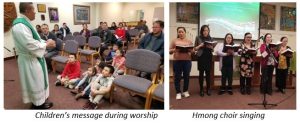 for the Tuscola County Sherriff Department, the Civil Air Patrol, and U.S. Army Reserve. He holds degrees and certifications in numerous fields, including law, criminal justice, education, an M.Div. and D.Min. As a tireless missionary, Pastor Yang drew Hmong members to Our Savior from across the state of Michigan, worshipping first in the Bickel Chapel and then, when they outgrew that space, in the Music Room. At one point, 30-50 people were worshipping each week, with a Bible Study, youth group, choir, and children’s ministries. They held monthly Hmong potlucks and Egg Roll Sundays twice a year. Hundreds of Egg Rolls were fried up early on a Sunday morning and sold in all the services as a fundraiser for Hmong ministry. The number of Hmong immigrants arriving in the U.S. slowed down to a trickle, and the Hmong ministry began serving the 2nd and 3rd generation of Hmong-Americans.
for the Tuscola County Sherriff Department, the Civil Air Patrol, and U.S. Army Reserve. He holds degrees and certifications in numerous fields, including law, criminal justice, education, an M.Div. and D.Min. As a tireless missionary, Pastor Yang drew Hmong members to Our Savior from across the state of Michigan, worshipping first in the Bickel Chapel and then, when they outgrew that space, in the Music Room. At one point, 30-50 people were worshipping each week, with a Bible Study, youth group, choir, and children’s ministries. They held monthly Hmong potlucks and Egg Roll Sundays twice a year. Hundreds of Egg Rolls were fried up early on a Sunday morning and sold in all the services as a fundraiser for Hmong ministry. The number of Hmong immigrants arriving in the U.S. slowed down to a trickle, and the Hmong ministry began serving the 2nd and 3rd generation of Hmong-Americans.
As the Hmong population began spreading across the U.S. and moving away, the attendance at the Hmong services dwindled. St. Michael’s concluded their Hmong services in 2022. In 2025, Pastor Lang Yang accepted a full time position as a chaplain in Winterhaven, Florida. The remaining Hmong members at Our Savior decided that this was the time for them to join the regular English services. With praise and thanksgiving to God for the work of the Holy Spirit, for the 389 baptisms, and for the ongoing mission of the church, Our Savior officially welcomed the Hmong members into their regular services and concluded a significant era of Gospel outreach through Hmong worship services. The mission continues, however, through the ongoing efforts of the church and school to fulfill the Great Commission and make disciples of all nations through baptizing and teaching. We look forward to the Revelation 7 church of all tribes, peoples, and languages, gathered around the throne worshipping the Lamb, our Lord Jesus Christ who draws all people to Himself. To Him be the glory in the church and throughout all generations. Amen!
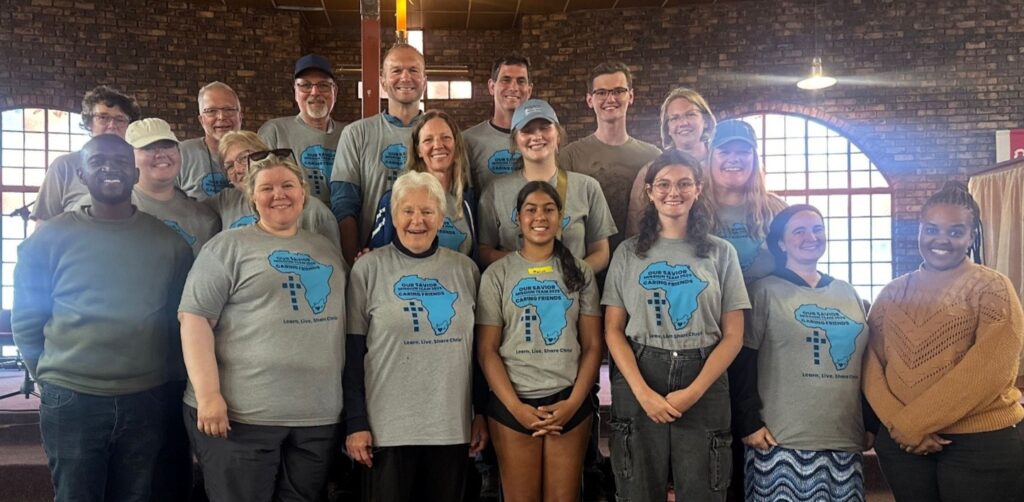 Our Savior sent a mission team of 18 people to serve our ministry partners in Middelburg, South Africa, June 26 – July 8, 2025. It was an amazing opportunity to work alongside and encourage our ministry partners in Middelburg. It was a trip filled with God-sightings! Joining Jesus on His mission, this team visited our partner church, the school, preschool, and orphanage in Middelburg, and the seminary in Pretoria. They sang, danced, played, and put on several ministry events including a VBS, a Feeding Program, and a Day of Serving.
Our Savior sent a mission team of 18 people to serve our ministry partners in Middelburg, South Africa, June 26 – July 8, 2025. It was an amazing opportunity to work alongside and encourage our ministry partners in Middelburg. It was a trip filled with God-sightings! Joining Jesus on His mission, this team visited our partner church, the school, preschool, and orphanage in Middelburg, and the seminary in Pretoria. They sang, danced, played, and put on several ministry events including a VBS, a Feeding Program, and a Day of Serving.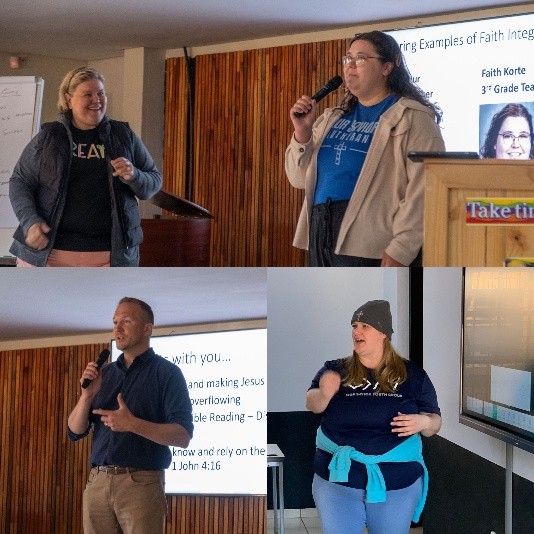
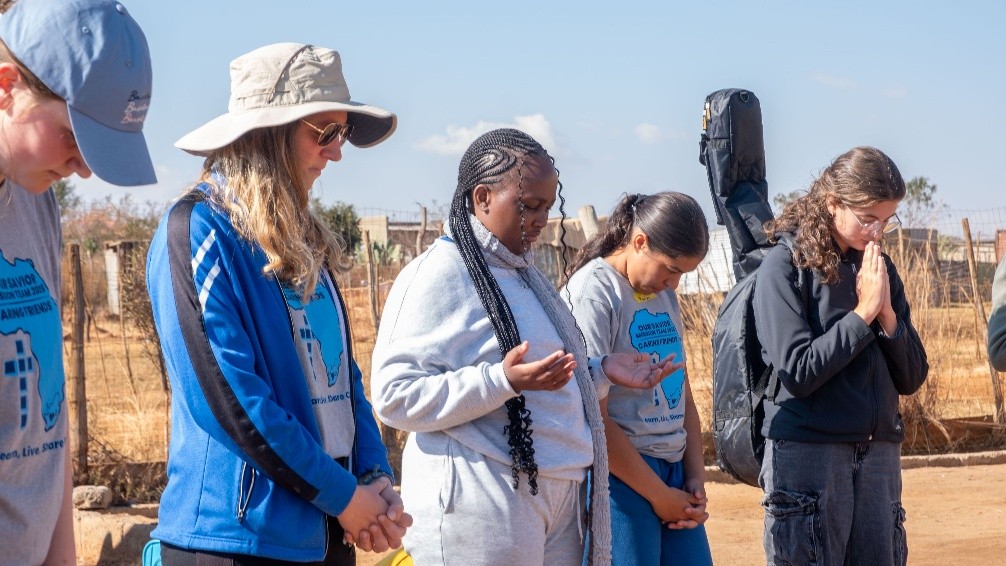
 I am forever changed by this trip and still think about our South Africa people every day. When I reflect back on our mission to South Africa this past July, I struggle with narrowing it down to one thing that stood out because there were so many ways in which I could see God at work. However, I am so thankful that I was given the honor and privilege to travel on this mission trip. Then I think about how wonderful it was to work alongside all of the others that went – what a blessing to be able to work with such an amazing team. Most importantly, I was able to see firsthand how God is working in and through the people of Middleburg, South Africa.
I am forever changed by this trip and still think about our South Africa people every day. When I reflect back on our mission to South Africa this past July, I struggle with narrowing it down to one thing that stood out because there were so many ways in which I could see God at work. However, I am so thankful that I was given the honor and privilege to travel on this mission trip. Then I think about how wonderful it was to work alongside all of the others that went – what a blessing to be able to work with such an amazing team. Most importantly, I was able to see firsthand how God is working in and through the people of Middleburg, South Africa. 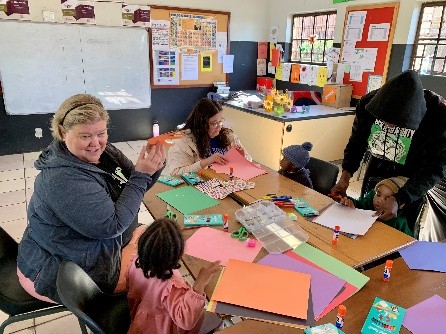 those meals otherwise. There were three areas where we worked – the garden, the kitchen, and the play yard. I was excited to participate and help in any way that I could and was fortunate to be in the play yard where I met a little girl. I ended up playing with her for most of the time I was there. She was the happiest little girl there and wore a smile the entire time. We played a lot of different games and for a bit we were separated playing with different people. When she saw me again she loudly exclaimed, “My friend, there you are!” and wrapped her arms around me for a hug. I was so touched by her calling me her friend. We had just spent a morning together and we weren’t even speaking the same language, but I was her friend. It was a wonderful witness to me and reminded me how Jesus sees me, too. I am His friend. The people of Middelburg and especially Doornkop are my friends.
those meals otherwise. There were three areas where we worked – the garden, the kitchen, and the play yard. I was excited to participate and help in any way that I could and was fortunate to be in the play yard where I met a little girl. I ended up playing with her for most of the time I was there. She was the happiest little girl there and wore a smile the entire time. We played a lot of different games and for a bit we were separated playing with different people. When she saw me again she loudly exclaimed, “My friend, there you are!” and wrapped her arms around me for a hug. I was so touched by her calling me her friend. We had just spent a morning together and we weren’t even speaking the same language, but I was her friend. It was a wonderful witness to me and reminded me how Jesus sees me, too. I am His friend. The people of Middelburg and especially Doornkop are my friends.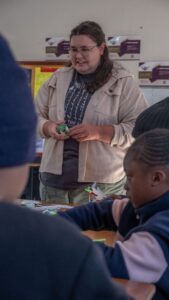 Shine. Jesus shines through everything. It was such a blessing to witness Him working and shining through our friends in South Africa and to be able to learn and work alongside them to spread His love. St. Peter Christian College (school), Caring Friends, and Amajuba Children’s Home reflect His light in so many amazing ways. I saw His magnificent creation on the safari radiate His glory. Yes, Jesus even shined through 66 hours of travel due to a missed connection flight and unexpected layovers.
Shine. Jesus shines through everything. It was such a blessing to witness Him working and shining through our friends in South Africa and to be able to learn and work alongside them to spread His love. St. Peter Christian College (school), Caring Friends, and Amajuba Children’s Home reflect His light in so many amazing ways. I saw His magnificent creation on the safari radiate His glory. Yes, Jesus even shined through 66 hours of travel due to a missed connection flight and unexpected layovers. 
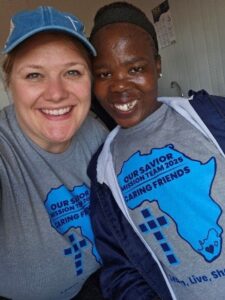
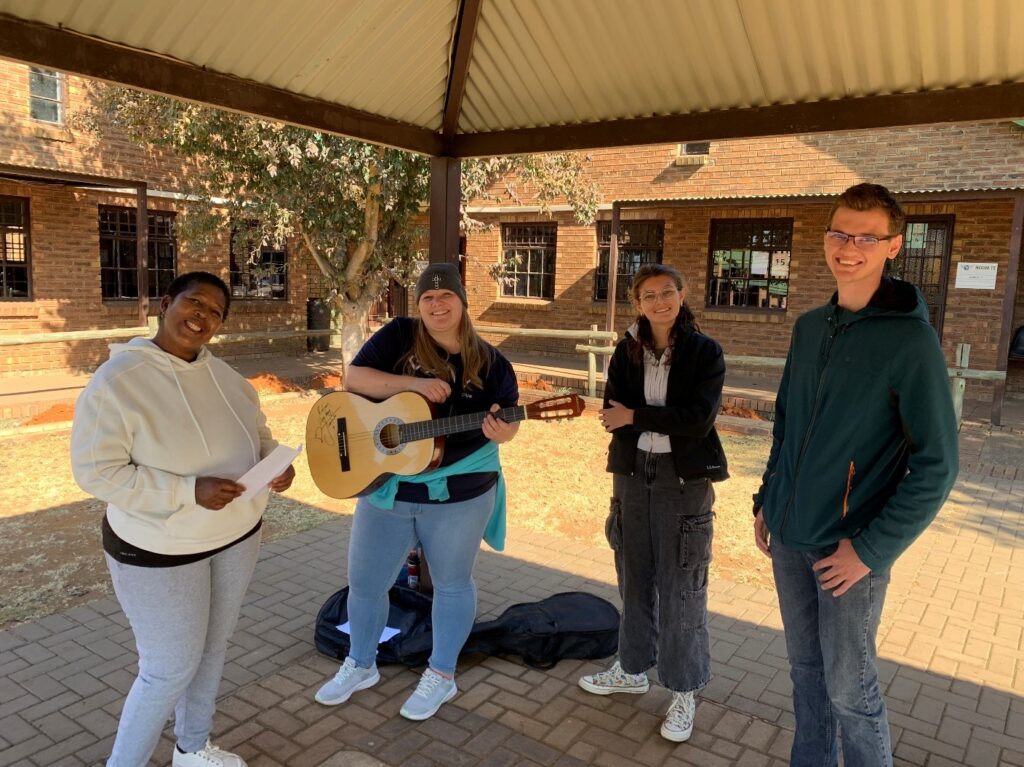 scripture and music combine, there is unity.
scripture and music combine, there is unity. Hello, I’m Pastor Chris. I was born in 1995, started high school in 2009, graduated from high school in 2013, graduated from college in 2017, had my year of vicarage cut short by COVID-19, learned what ‘Zoom’ was, graduated from Seminary in 2021, and was called to serve here at Our Savior in July of 2021. My birth year does a few things: It tells you how old I am, and it pigeonholes me into a category talked about by many different social scientists.
Hello, I’m Pastor Chris. I was born in 1995, started high school in 2009, graduated from high school in 2013, graduated from college in 2017, had my year of vicarage cut short by COVID-19, learned what ‘Zoom’ was, graduated from Seminary in 2021, and was called to serve here at Our Savior in July of 2021. My birth year does a few things: It tells you how old I am, and it pigeonholes me into a category talked about by many different social scientists.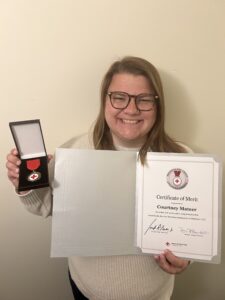 Coming upon an unconscious man in a store would be a shock to anyone. But would you know how to help? CPR stands for cardiopulmonary resuscitation. It can help save a life during cardiac arrest, when the heart stops beating or beats ineffectively. All Lutheran school and early childhood teachers and staff undergo CPR training on a regular basis.
Coming upon an unconscious man in a store would be a shock to anyone. But would you know how to help? CPR stands for cardiopulmonary resuscitation. It can help save a life during cardiac arrest, when the heart stops beating or beats ineffectively. All Lutheran school and early childhood teachers and staff undergo CPR training on a regular basis.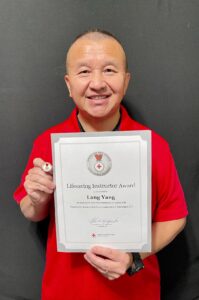 training and sprang into action. While Carly notified emergency and Target employees, Courtney began performing CPR until paramedics arrived. The man, who was in his late-20’s or early 30’s, received medical attention and survived.
training and sprang into action. While Carly notified emergency and Target employees, Courtney began performing CPR until paramedics arrived. The man, who was in his late-20’s or early 30’s, received medical attention and survived.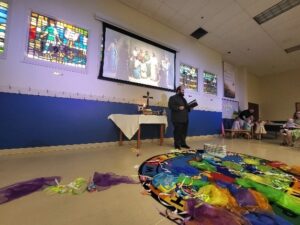 Flags being thrown up in the air. Instruments being played throughout the whole service. Snacks! The Gospel! Worship! A “no-cleanup corner.” And of course, families with even the youngest worshippers being able to worship together.
Flags being thrown up in the air. Instruments being played throughout the whole service. Snacks! The Gospel! Worship! A “no-cleanup corner.” And of course, families with even the youngest worshippers being able to worship together. Coming out of COVID, many families with young children were the demographic that took awhile to make their way back to worship, for a litany of reasons: online worship was easier, it takes a lot to get several children and adults ready to go to church, kids can’t sit still for an hour, they’ll be loud, etc. All valid reasons, but as we know, there is nothing like the real thing.
Coming out of COVID, many families with young children were the demographic that took awhile to make their way back to worship, for a litany of reasons: online worship was easier, it takes a lot to get several children and adults ready to go to church, kids can’t sit still for an hour, they’ll be loud, etc. All valid reasons, but as we know, there is nothing like the real thing.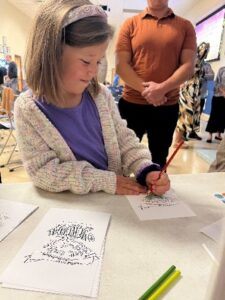 So what does a normal Connect service look like?
So what does a normal Connect service look like?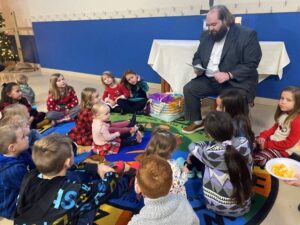
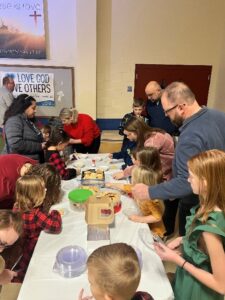 Phew. That’s a lot there! And for the most part that service is around 50-60 minutes. Throughout the whole service children are invited to get up, move around, grab a snack, play on the nugget couch, play with magnatiles, dance, express their worship, and have fun!
Phew. That’s a lot there! And for the most part that service is around 50-60 minutes. Throughout the whole service children are invited to get up, move around, grab a snack, play on the nugget couch, play with magnatiles, dance, express their worship, and have fun!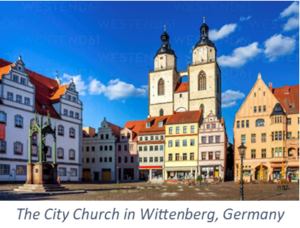 The collection was so popular, that by the end of the year, a second edition was published, called the Erfurt Enchiridion (Handbook), which may be considered the first proper hymnal in the Lutheran Church. It was published in Erfurt in 1524 and had twenty-six songs, which included the original eight published earlier that year. Of the twenty-six, eighteen were written by Martin Luther. Other composers were Paul Speratus, Justus Jonas, Elisabeth Cruciger, and one by Jan Hus. While these songs could be sung in the churches, the handbook was intended for home use and other occasions. People were to sing these songs everywhere. Sixteen of these songs were included in the first English hymnal printed in London in 1555. Congregational singing continued to spread as the Lutheran Reformation advanced. Today we take singing in church for granted.
The collection was so popular, that by the end of the year, a second edition was published, called the Erfurt Enchiridion (Handbook), which may be considered the first proper hymnal in the Lutheran Church. It was published in Erfurt in 1524 and had twenty-six songs, which included the original eight published earlier that year. Of the twenty-six, eighteen were written by Martin Luther. Other composers were Paul Speratus, Justus Jonas, Elisabeth Cruciger, and one by Jan Hus. While these songs could be sung in the churches, the handbook was intended for home use and other occasions. People were to sing these songs everywhere. Sixteen of these songs were included in the first English hymnal printed in London in 1555. Congregational singing continued to spread as the Lutheran Reformation advanced. Today we take singing in church for granted.